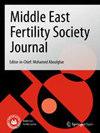The impact of long non-coding RNA H19 on metabolic features and reproductive phenotypes of Egyptian women with polycystic ovary syndrome
IF 1.3
Q4 REPRODUCTIVE BIOLOGY
引用次数: 0
Abstract
Polycystic ovary syndrome (PCOS) is known as the most common endocrine/metabolic disorder in women of reproductive age. Long non-coding RNAs (lncRNAs) regulate a wide range of physiological and pathological processes. We designed this study to evaluate lncRNA H19 relative expression in patients with PCOS and to evaluate its impact on metabolic features and reproductive phenotypes of Egyptian women with polycystic ovaries. The case–control study enrolled 50 control groups and 50 patients, with PCOS. The selection of patients with PCOS depended on the diagnosis according to the Rotterdam Consensus (2004). The lncRNA H19 were measured by real-time quantitative polymerase chain reaction (RT-qPCR). The lncRNA H19 level was significantly higher in the PCOS group (1.71 ± 0.48) compared to controls (0.924 ± 0.081). Furthermore, lncRNA H19 levels were significantly positively correlated with anthropometric and metabolic parameters including BMI, waist/hip ratio, TC, TG, LDL, FPG, FSI, HbA1c, and HOMA-IR. Regarding reproductive phenotypes features, hirsutism score, and AFC levels were significantly positively correlated with lncRNA H19 levels. The linear regression test revealed that BMI and AFC were the only parameters independently associated with lncRNA H19 among other studied parameters. Interestingly, receiver operating characteristic curve (ROC) analysis detected that the area under the curve (AUC) for the lncRNA H19 was 0.925 (95% CI = 0.856–0.955) with sensitivity = 96.4%, specificity = 96%, and the cutoff values (1.08). Thus, the predictive power of lncRNA H19 of PCOS was highly sensitive and specific. PCOS patients had significantly higher lncRNA H19 levels than controls. lncRNA H19 levels were significantly positively correlated with metabolic risk factors as well as clinical and laboratory features of PCOS.长非编码 RNA H19 对埃及多囊卵巢综合征妇女代谢特征和生殖表型的影响
多囊卵巢综合征(PCOS)是育龄妇女最常见的内分泌/代谢疾病。长非编码 RNA(lncRNA)可调控多种生理和病理过程。我们设计了这项研究,以评估 lncRNA H19 在多囊卵巢综合征患者中的相对表达,并评估其对埃及多囊卵巢妇女的代谢特征和生殖表型的影响。这项病例对照研究招募了 50 名对照组和 50 名多囊卵巢综合症患者。多囊卵巢综合症患者的选择取决于根据鹿特丹共识(2004 年)做出的诊断。通过实时定量聚合酶链式反应(RT-qPCR)测量了lncRNA H19。与对照组(0.924 ± 0.081)相比,多囊卵巢综合征组的lncRNA H19水平(1.71 ± 0.48)明显较高。此外,lncRNA H19水平与人体测量和代谢参数(包括体重指数、腰围/臀围比、总胆固醇、总胆固醇、低密度脂蛋白、脂肪肝、脂肪肝指数、血红蛋白A1c和HOMA-IR)呈显著正相关。在生殖表型特征方面,多毛症评分和 AFC 水平与 lncRNA H19 水平呈显著正相关。线性回归测试显示,在其他研究参数中,体重指数和AFC是唯一与lncRNA H19独立相关的参数。有趣的是,接收者操作特征曲线(ROC)分析发现,lncRNA H19的曲线下面积(AUC)为0.925(95% CI = 0.856-0.955),灵敏度为96.4%,特异度为96%,临界值为1.08。因此,lncRNA H19对多囊卵巢综合症的预测能力具有高度敏感性和特异性。多囊卵巢综合征患者的lncRNA H19水平明显高于对照组。lncRNA H19水平与代谢风险因素以及多囊卵巢综合征的临床和实验室特征呈显著正相关。
本文章由计算机程序翻译,如有差异,请以英文原文为准。
求助全文
约1分钟内获得全文
求助全文
来源期刊

Middle East Fertility Society Journal
REPRODUCTIVE BIOLOGY-
CiteScore
2.80
自引率
0.00%
发文量
32
审稿时长
45 weeks
 求助内容:
求助内容: 应助结果提醒方式:
应助结果提醒方式:


